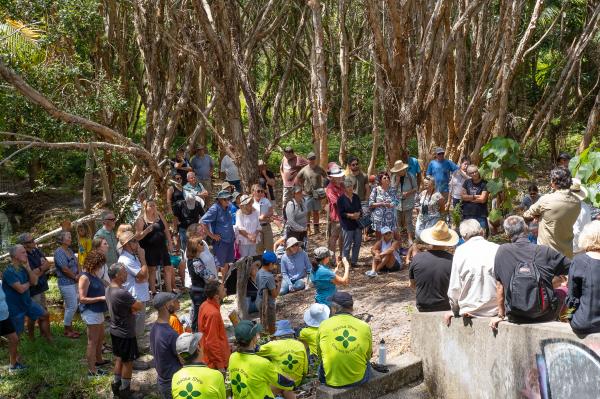
More than 50 people came to glossy black cockatoo waterhole at Rainbow Park, Sunrise Beach on Saturday to celebrate the bush care regeneration work of the Burgess Creek Project and listen to talks by glossy black cockatoo experts.
Project leader Ben Alexander said there had been five working bees conducted on the site, hundreds of bags of the weed Singapore daisy removed and 500 native trees planted and a further 500 glossy black cockatoo feeding trees were planned to be planted next year in Rainbow Park.
He said the Noosa Men’s Shed had assisted the project by building a dozen glossy black nesting boxes and another 15 boxes would be built thanks to donations from McGrath Noosa and Noosa Landcare.
Ben said volunteers contributed about $50,000 in volunteer hours toward the community through the project.
PhD candidate Daniella Teixeira, Dr Gabriel Conroy and Janet Carew spoke to the gathering about the rare and vulnerable glossy black cockatoos.
After spending three years recording and interpreting bird sounds of the nesting birds on Kangaroo Island for her PhD Daniella will be able to provide information on the best nesting locations for the cockatoos in Burgess Creek to guide the siting of nesting boxes.
She said the cockatoos travelled up to 12 km from nests in search of food for their young.
Dr Gabriel Conroy spoke about the fussy feeding habits of the glossy black cockatoos that only feed from the Allocasuarina tree and restrict their diets further to specifically selected trees. Gabriel said research had been conducted on genetic and environmental factors of feed trees to try to determine the reasons for their selection which could inform the propagation of future feed trees that appeal to the fussy eaters.
Noosa councillor Joe Jurisevic praised the community effort in bringing together volunteers and experts and capturing local knowledge in the project that was regenerating the bushland to create an improve habitat for native flora and fauna including glossy black cockatoos.Ben said Noosa Landcare would take over care of the bushland restoration over the summer months and volunteers will return to work on the project in February-March next year.








